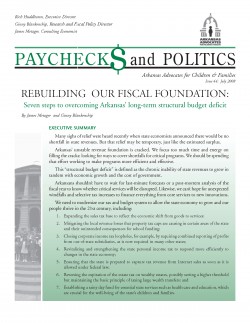
Arkansas’s state and local governments play an important role in providing a wide variety of critical services to their citizens. They ensure that our children and the elderly have adequate health care; that roads and parks are well maintained; and that our public schools and universities are excellent places to learn. During these tough economic times, our government plays an especially vital role in helping meet the basic needs of its citizens. State budget cuts, such as the recent announcement to slash Arkansas’s budget by $107 million (2.4%) for fiscal year 2009, hit our most vulnerable children and families the hardest.
Even when the economy is relatively strong or the state is lucky enough to have a modest or temporary surplus, Arkansas still struggles to raise adequate funds to pay for many crucial services. Arkansas is strapped by what is known as a “structural deficit,” defined as “the chronic inability of state revenues to grow in tandem with economic growth and the cost of government.” In other words, revenues in Arkansas do not keep pace with the need to fund current programs and services.
This fundamental structural problem not only makes it difficult to provide essential services or meet new and emerging needs, but it also limits the state’s ability to create a tax system that is fair to all of its citizens, especially low- and middle-income families who bear a disproportionate share of the tax burden. The solution, however, is not simply to cut the budget and curtail vital services. Nor is it to increase taxes that take the greatest toll on low-income families, such as the 2004 increase in the state’s sales tax to pay for education reform. Arkansas also should not rely on stop-gap measures, such as lotteries, when times get tough. Instead, to truly meet the needs of all state residents in the 21st century, Arkansas must undertake an overall modernization of its tax and budget system.
